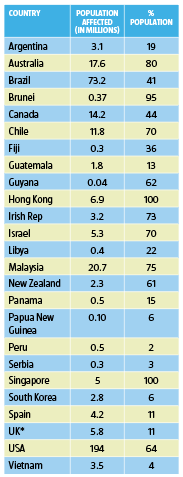
Most of us brush it on our teeth every day. It’s also in our tea—and there’s the chance we’ll consume even more of it if we drink a glass of tap water. Yes, fluoride is good for us, and it prevents our teeth from decaying and, as we get older, reduces our chances of osteoporosis, or so its advocates tell us.
Because fluoride can apparently do so much for our health, it is a medicine, a view that’s supported in law and by medical authorities around the world. The US Department of Health & Human Services stated in 2000: “Fluoride, when used in the diagnosis, cure, mitigation, treatment or prevention of disease in man or animal is a drug that is subject to Food and Drug Administration (FDA) regulation.” And, if there was any doubt, the august WebMD site states: “Fluoride is a form of the chemical element fluorine. It is used as medicine.”1
But if it is a medicine, adding it to the public drinking water becomes a “state-imposed form of non-consensual mass medication,” says Douglas Cross, from the Collegium Basilica of Advanced Study in Switzerland. Our basic right to clean, uncontaminated drinking water has been abrogated by enforced medicalization.2
Governments around the world have invariably ignored the legalities to push ahead with their fluoridation programs. The US was the first when in 1945 it fluoridated the water in Grand Rapids, Michigan, raising levels to 1 mg/L (milligrams per liter).
Today, around 64 percent of America’s public water is fluoridated, a rollout hailed by the Centers for Disease Control and Prevention (CDC) as one of the greatest achievements in public health in the twentieth century.
Despite the triumphalism, the US is slowly tiptoeing away from fluoridation. In 2015, its Department of Health and Human Services lowered the safe level to just 0.7 mg/L after dentists started to report a rise in cases of dental fluorosis, a discoloring of the teeth caused by excess fluoride. The CDC confirmed their fears with a study that revealed 40 percent of adolescent Americans had the condition.
Many of us are already getting enough fluoride without fluoridation anyway; it makes its way into our water from natural sources such as mineral deposits, and we top that up by brushing our teeth with fluoride-boosted toothpaste and mouthwashes.
Not that many other countries ever followed the US example. Apart from Ireland, almost no other European country fluoridates its water to any large extent, while, worldwide, only Australia, Chile, Israel, New Zealand and Singapore have been major adopters.
While the international mood has shifted to one that classifies fluoridation as an interesting post-war experiment that has become redundant in a more affluent society, the contrarian UK is moving in the opposite direction to fully embrace water fluoridation.
Its government is planning to gain executive powers to introduce fluoridation schemes anywhere around the country. Just 11 percent of the UK is currently fluoridated, and the low take-up is partly explained by resistance from local authorities, with 75 of the UK’s 333 local authorities refusing to introduce fluoridation. The public also opposes it, with 72 percent of people in a poll of around 10,000 residents in Southampton voting against it.
Sweeping away any opposition, the UK government has decided to “seize back control,” according to the former health secretary Matt Hancock, through the Health and Care Bill, which could become law this summer. It will give ultimate power to the government to ignore local objections and implement fluoridation across the nation.
With its overwhelming majority in Parliament, the British government is likely to win the day—but, paradoxically, its new law could be unlawful. It has been advised by the MHRA (Medicines and Healthcare products Regulatory Authority) that fluoride isn’t a medicine when clearly it is; it’s an opinion that may be a convenient position for governments to adopt, but it’s a “legal fiction,” and one that would fail if challenged in the courts.3
For a medicinal product, fluoride has had a relatively easy ride down the years. While health authorities have seen a correlation—high fluoride regions seem to have fewer cases of tooth decay among its children—a direct causation has been harder to establish.
A near-fatal blow against fluoridation was landed by the prestigious Cochrane Collaboration, an independent group of medical reviewers. They reviewed 20 studies that were positive about fluoridation, but their findings can’t be relied on. Most were biased, too small or so old that they had been carried out even before fluoride toothpaste became widely used, the Cochrane researchers discovered.
Although the rate of dental caries (decay) has fallen over the past 40 years, many factors can explain the trend, from improved nutrition and dentistry to better understanding of oral care, they say.4
If there is a marginal benefit to fluoridation, it is offset by the potential harm it can do to children, mainly because they can’t process fluoride as efficiently as adults. They excrete just 45 percent of the mineral, which means 55 percent is retained in their body, and this may be greater still in children with poor kidney and liver function.
Researchers from Mount Sinai Hospital saw the evidence for themselves when they analyzed blood samples from 1,983 children and compared them to fluoride levels in their homes. All the children had high fluoride levels, even though many lived in areas where the public water had fluoride levels below the 0.7 mg/L ‘safe’ level. 5
Fluoride can reduce thyroid gland function and even cause hypothyroidism or Hashimoto’s disease. Researchers have found higher than expected rates of hypothyroidism in areas with fluoride levels above 0.7mg/L in the UK, and they were even a third higher where levels were more than 0.3mg/L. Governments should abandon fluoridation, and instead rely on fluoride toothpastes, the researchers say.6
There have also been concerns that fluoride can interfere with a child’s brain development—and this could be a reaction not to fluoride itself but to the chemical hexafluorosilic acid, a neurotoxin that is added to public water to create the fluoride.
Scientists argue that the fluoride levels in water are far too low to cause any neurological damage, but more than 50 studies have found some association between high fluoride levels and low IQ scores in children.
Several new studies have found that fluoride can even pass from the mother to the fetus, finding a way through the placenta wall. Researchers from York University in Toronto analyzed samples from 512 mothers and their children, 141 of whom lived in high-fluoride areas. They discovered that the women who drank the most fluoridated water when they were pregnant had children who had, on average, lower IQ scores by the time they were four. There was a four-point drop in scores for every 1 mg/L of fluoride found in the mother’s urine.7
A similar pattern has been seen by other researchers. Researchers in China took a second look at 26 studies that had involved more than 7,000 children and concluded that high fluoride levels were strongly linked to lower IQ levels.8
These are the countries that fluoridate their public water to some extent.

*Introducing mass fluoridation this year
Source: Fluoride Action Network (fluoridealert.org)
If fluoride does help stop tooth decay, around 0.7 mg/L should be enough without causing fluorosis. In fact, it’s considered “adequate intake”—the terminology that’s used instead of recommended dietary allowance (RDA) because of our many encounters with the chemical—for children, while the average adult needs around 3 mg a day.
Brushing your teeth just once a day provides around 1.5 mg of fluoride, so any adult who brushes first and last thing every day is getting as much as they need to keep teeth healthy.
Toothpaste that contains fluoride isn’t novel. The first products were launched before the turn of the twentieth century, but it has only been in the last 30 years or so that we have seen a wider use, with most people now buying the products.
Dental decay is a disease of neglect and poverty. Education and public funding support are better ways forward than this “state-imposed form of non-consensual mass medication.”
|
References |
|
|
1 |
UK Dept of Health and Social Care White Paper, March 2021. Statement of Douglas Cross FRSB |
|
2 |
www.webmd.com, “Fluoride – Uses, Side Effects, and More” |
|
3 |
Medical Law Int, 2012; 12: 11–27 |
|
4 |
Cochrane Database Syst Rev, 2015: 6: CD010856 |
|
5 |
Environ Int, 2019; 132; 105012 |
|
6 |
J Epidemiol Community Health, 2015; 68(7): 619–24 |
|
7 |
JAMA Pediatr, 2019; 173(10): 940–8 |
|
8 |
Public Health, 2018; 154: 87–97 |
What do you think? Start a conversation over on the... WDDTY Community